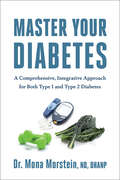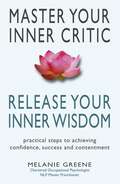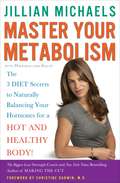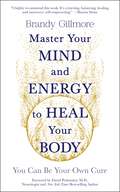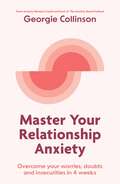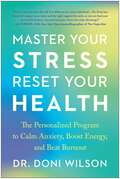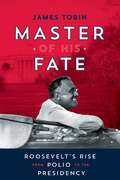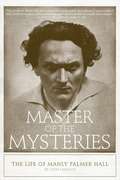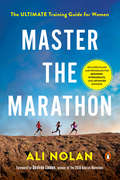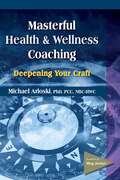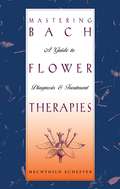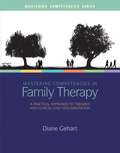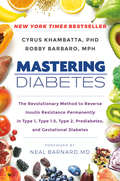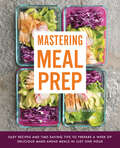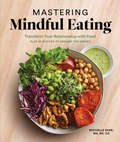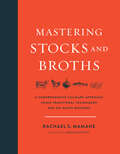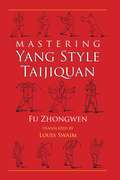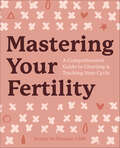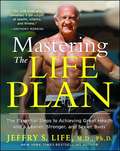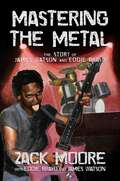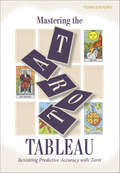- Table View
- List View
Master Your Diabetes: A Comprehensive, Integrative Approach for Both Type 1 and Type 2 Diabetes
by Mona Morstein&“Dr. Morstein draws from the best of conventional and integrative therapies to provide diabetic patients an easy-to-implement program to regain their health.&”—Robb Wolf, author of Wired to EatThe evidence is clear: We are in the midst of a worldwide diabetes epidemic. In the United States alone, one in three Americans is either diabetic (29 million patients) or prediabetic (87 million patients), costing an annual $242 billion in medical treatments.In Master Your Diabetes, naturopathic physician and diabetes expert Dr. Mona Morstein shows how people with both type 1 and type 2 diabetes can gain and maintain excellent control of their blood sugar levels, preventing and even reversing existing complications through education combined with medical support and encouragement. This is the first comprehensive guide for patients, caregivers, and medical practitioners to demonstrate an integrative approach based on the &“eight essentials&” of treatment and prevention: a low-carb diet, exercise, good sleep, stress management, healing the gut, detoxification, supplementation, and medications.Topics covered include:Important physical exams and lab workConventional diets and non-insulin medicationsInsulinLow-carb diets and how they apply to different food groupsLifestyle factors, including exercise, stress management, and the microbiomeDiabetic supplementationPediatric diabetesAn indispensable resource, Master Your Diabetes will empower readers to take control of their condition and continue living full, active, enjoyable, and long lives.
Master Your Inner Critic: Release Your Inner Wisdom
by Melanie GreeneEveryone has messages running through their head but for many people the messages are negative and self-critical. This is the first book to provide a range of tried and tested techniques for transforming your inner critic. By using these techniques you can transform your thoughts, feelings and behaviour to become a happier person.
Master Your Inner Critic: Release Your Inner Wisdom
by Melanie GreeneEveryone has messages running through their head but for many people the messages are negative and self-critical. This is the first book to provide a range of tried and tested techniques for transforming your inner critic. By using these techniques you can transform your thoughts, feelings and behaviour to become a happier person.
Master Your Metabolism: The 3 Diet Secrets to Naturally Balancing Your Hormones for a Hot and Healthy Body!
by Jillian Michaels Mariska Van AalstDoes it feel as if you’re fighting your body to lose even one pound—or just to maintain your current weight? Respected health and wellness expert and bestselling author Jillian Michaels has been there, too. So she consulted top experts in the field of metabolism and discovered that she’d inadvertently been abusing her endocrine system for years. After “fixing” her own metabolism, she decided to share what she learned by devising this simple, 3-phase plan that engages all the weight-loss hormones (including the friendly HGH, testosterone, DHEA; and the not-so-friendly: insulin, cortisol, and excess estrogen). In Master Your Metabolism, discover how to:•REMOVE “anti-nutrients” from your diet•RESTORE foods that speak directly to fat-burning genes •REBALANCE energy and your hormones for effortless weight lossMichaels offers a wealth of information throughout, including: shopping lists and online shopping resources, hormone-trigger food charts, how to eat “power nutrient” foods on a budget, smart strategies for eating out, quick and easy recipes, as well as mini-programs for addressing PMS, andropause, metabolic syndrome, PCOS, and menopause.From the Hardcover edition.
Master Your Mind and Energy to Heal Your Body: You Can Be Your Own Cure
by Brandy GillmoreAMAZON #1 BESTSELLERA captivating must-read, this book unveils the astounding hidden potential of the human mind. If you are interested in alternative healing, or if you have been struggling for years with your own recovery, then you will not want to miss this book.Brandy Gillmore reveals the groundbreaking research that enabled her to heal herself from a debilitating condition deemed incurable. Since then, Brandy has been able to show others how to heal themselves from a wide range of pain and illnesses and has also demonstrated mind-body healing using medical equipment. Due to unprecedented results, Brandy's work has been featured in several documentaries and docuseries. Now, for the first time, Brandy shares her research through this remarkable book so that you too can unlock the boundless potential of your own mind.In Part One, this book takes you on an extraordinary journey of discovery. Starting Brandy's accident and the disheartening news from her doctors that there was nothing anyone could do for her, it moves onto Brandy's desperate quest to find a cure, and all evidence continued to point to the mind as holding the ability to activate the body's innate self-healing mechanism. However, despite the evidence, Brandy was still skeptical. She had already tried practices like "mind over matter" meditation, and the power of belief, but none of them worked to heal her body. Furthermore, given the severity of Brandy's condition, it seemed impossible to her that her mind could heal her physical body.As Brandy delved further into medical research, she was astonished by her findings. Not only did she uncover concealed studies that vividly illustrated the mind's potential to impact on our physical body, but she also discovered scientifically documented information about the body's energy that challenged her preconceived notions about health.For example: - Did you know that people with multiple personalities can experience different illnesses in different personalities? For example, one personality may have back pain, while another may have asthma. Medical research has even documented a case of a woman who was blind in certain personalities but had normal vision in others.- Did you know that "energy" in the body is not a spiritual concept but has actually been medically documented? In fact, the medical scientist who first documented energy in the body (biophotons) in the 1920s was nominated for a Nobel Prize eleven times!As Brandy continued to explore each medical anomaly, from the placebo effect to spontaneous remission and everything in between, she was able to uncover even more obscure research and gain clarity as to what she needed to do to activate her body's self-healing mechanisms. That's when she began creating a step-by-step process. Over the years, this process has further evolved. Brandy now calls it the "GIFT method" because, as the name suggests, when we connect with our own innate ability to heal ourselves, it truly becomes a life-changing gift.In Part Two, Brandy shares this incredible step-by-step method, along with inspiring stories of individuals who have used this process of mind-body-energy healing to transform their lives and achieve self-healing. It is truly incredible what we are all capable of.
Master Your Mind and Energy to Heal Your Body: You Can Be Your Own Cure
by Brandy GillmoreAMAZON #1 BESTSELLERWhat if you could learn how to heal your injuries, pain, or illness using only the power of your mind?"This is essential reading for both those receiving care as well as those who provide it."-David Perlmutter, M.D., neurologist and New York Times best-selling author"I highly recommend this book. It is empowering and has the ability to transform the way the world sees health and healing."-Jack Canfield, co-author of the Chicken Soup for the Soul® series and The Success Principles™A captivating must-read, this book unveils the astounding hidden power of the human mind. If you are working on self-healing, or if you have been struggling for years with your own recovery, then you will not want to miss this book.After an unexpected event, Brandy Gillmore found herself disabled and desperately searching for answers to heal. She tried every healing approach she could find, including special diets, supplements, meditation, and everything in between, but to no avail. It wasn't until Brandy delved deeper into the workings of the mind that she discovered obscure research that helped her unlock the mystery of the body's innate healing ability, resulting in her full recovery and a profound transformation in her life.Since uncovering these remarkable findings, Brandy has gained recognition for helping others heal themselves, even from extreme illness. She has also demonstrated how to alleviate chronic pain within minutes and documented these results using medical thermal imaging equipment.In this groundbreaking book, you will...· Gain a revolutionary understanding of the body's ability to heal itself· Learn the key factors to activate healing (the 5 Factors for GIFT Mind-Body Healing™)· Implement a step-by-step process with powerful tools and techniques that can help you heal and free yourself from mental, emotional, and physical painBrandy's journey from having a debilitating incurable condition to complete recovery is more than inspirational; it can be seen as a blueprint for anyone facing seemingly insurmountable health challenges.Throughout history, for thousands of years, spiritual teachings have documented the mind's remarkable ability to heal. Furthermore, there is medically documented proof that our minds can impact our health in a variety of different ways, such as research on stress or the placebo. This book takes these well-known concepts to an entirely new level to help you understand how to tap into your body's own innate ability to heal itself.Written from a deep sense of mission and love, Master Your Mind to Heal Your Body has the ability to change your world by showing you how to harness the greatest gift you have - the power of your mind - to heal your body and improve the quality of your life.Get started today and learn how you can be your own cure!
Master Your Relationship Anxiety: Overcome your worries, doubts and insecurities in 4 weeks
by Georgie CollinsonWhy am I feeling anxious in love, and what is this anxiety trying to tell me?Feel calmer, more trusting and more confident in your relationships.Master Your Relationship Anxiety delivers a simple four-week program for overcoming the mental and emotional stresses that can stop us being our best selves in relationships. Exploring the four types of relationship anxiety, this book provides holistic, practical and highly relatable advice to help you feel better able to love others and create the deeper connections we all crave. You'll find valuable personal growth hidden in the anxiety, worry, insecurity and doubt that relationships inevitably bring to the surface. Once you've mastered how to be calm and open in love, you can experience living life with an open heart -- the ultimate antidote to all our fears and anxiety.
Master Your Relationship Anxiety: Overcome your worries, doubts and insecurities in 4 weeks
by Georgie CollinsonWhy am I feeling anxious in love, and what is this anxiety trying to tell me?Feel calmer, more trusting and more confident in your relationships.Master Your Relationship Anxiety delivers a simple four-week program for overcoming the mental and emotional stresses that can stop us being our best selves in relationships. Exploring the four types of relationship anxiety, this book provides holistic, practical and highly relatable advice to help you feel better able to love others and create the deeper connections we all crave. You'll find valuable personal growth hidden in the anxiety, worry, insecurity and doubt that relationships inevitably bring to the surface. Once you've mastered how to be calm and open in love, you can experience living life with an open heart -- the ultimate antidote to all our fears and anxiety.
Master Your Stress, Reset Your Health: The Personalized Program to Calm Anxiety, Boost Energy, and Beat Burnout
by Doni WilsonLearn to manage stress and overcome anxiety with this customizable breakthrough program from leading adrenal distress/stress expert Dr. Doni Wilson. We have come to accept stress and anxiety as being hand-in-glove with being successful. Many of us believe that we are supposed to be superhumans and just ignore stress—carrying on with long hours and sleepless nights, suffering quietly with the headaches, tension, and stomach sensitivity, rather than risk being perceived as unable to &“keep up&” with the demands of modern life. But we&’re not robots or machines; we&’re human. While stress is inevitable, and, in certain situations, even necessary for effective functioning, we must keep it from overpowering our daily lives by learning how to harness stress to empower us. In Master Your Stress, Reset Your Health, Dr. Doni Wilson shows that the key to breaking the cycle is finding and treating your unique stress type. After more than 20 years working with thousands of patients, Dr. Doni has found that people generally fall into one of five types based on their adrenaline and cortisol levels throughout the day: the Night Owl, the Stress Magnet, Yawning on the Go, Tired and Wired, or Sluggish and Stressed. In this groundbreaking book, she'll help you identify your stress type--and give you the tools to make stress work for you. Your body&’s particular response is based on genetics and your lifestyle. Your pattern is unique—even in similar situations, different people may respond to that stress in a completely different way. Dr. Doni&’s customizable C.A.R.E. program is simple: Clean eating, Adequate sleep, Recovery, and Exercise. Dr. Doni shows you how to tailor each step of the program for your stress type to allow you to: Overcome exhaustion and fatigue Clear up brain fog and improve memory Optimize your body weight Stop insomnia Recover from anxiety and depression Relieve headaches, chronic pain, and digestive issues Increase your energy, sex drive, and immunity Prevent serious illnesses such as cancer, dementia, and heart disease Add years to your life Far too many of us have accepted the negative effects of stress and anxiety as a fact of life—pushing through rather than risking falling short of the demands of modern life. This groundbreaking guide will set you on a path to become resilient to stress, so you can thrive like never before.
Master of His Fate: Roosevelt's Rise from Polio to the Presidency
by James TobinMaster of His Fate by James Tobin is an inspiring middle-grade biography of Franklin Delano Roosevelt, with a focus on his battle with polio and how his disease set him on the course to become president.In 1921, FDR contracted polio. Just as he began to set his sights on the New York governorship—and, with great hope, the presidency—FDR became paralyzed from the waist down. FDR faced a radical choice: give up politics or reenter the arena with a disability, something never seen before. With the help of Eleanor and close friends, Roosevelt made valiant strides toward rehabilitation and became even more focused on becoming president, proving that misfortune sometimes turns out to be a portal to unexpected opportunities and rewards—even to greatness. This groundbreaking political biography richly weaves together medicine, disability narratives, and presidential history.Christy Ottaviano Books
Master of the Mysteries
by Louis Sahagun"And for anyone wishing to learn more about Manly Hall, Louis Sahagun's gripping biography is an insightful look at the life and times of one of the last century's most important mystical thinkers."--The Fortean TimesIn 1919, a Canadian teenager with a sixth grade education arrived by train to the wilds of Los Angeles. Within a decade he had transformed himself into a world-renowned occult scholar.His name was Manly Palmer Hall, author of the landmark publication The Secret Teachings of All Ages, regarded as the best introduction to Western esoteric ideas, and the founder of the Philosophical Research Society, which houses one of the biggest occult libraries in the United States.Hall became the twentieth century's most prolific writer and speaker on ancient philosophies, mysticism, and magic, and a confidant of Hollywood celebrities and politicians. In 1990, he died--some say he was strangled--in what remains an open-ended Hollywood murder mystery worthy of Raymond Chandler.Master of The Mysteries: The Life of Manly Palmer Hall offers an intimate portrait of this elusive luminary who set as his life's work the daunting task of reconciling scientific reason with ancient wisdom--issues that seekers and scientists still struggle with today.Author Louis Sahagun draws from Hall's massive archives and a wealth of interviews to provide an insider's view of the birth of a metaphysical subculture that continues to have a profound influence on movies, television, music, books, art, and thought.
Master the Marathon: The Ultimate Training Guide for Women
by Ali NolanA no-nonsense, interactive guide that empowers all women at all levels to run their strongest, best marathon everAs recently as 1966, women were forbidden to run in the marathon. Professionals—including doctors—believed it was physically impossible and dangerous for women to run more than a mile and a half. But as with many other barriers women have faced over time, we fought our way in. Today, women make up almost half of the marathoning population. Yet most marathon training manuals are written by men. And while these men are experts when it comes to how men can and should train, women need training programs tailored to our bodies—to our unique strengths and weaknesses—so that we can avoid injuries and run at our peak. The programming in this book was created by a woman, specifically for women. Master the Marathon is a comprehensive guide to marathon training for women at all levels of running—beginner, intermediate, and advanced. The book takes you through everything you need to know to be prepared for the 26.2 miles of the marathon, including detailed training plans, strength training programs, building your mental awareness of your physical body, nutrition, guidance on finding the best marathon for you, identifying and avoiding potential injuries, inspirational advice, and other unexpected pieces of wisdom. Both incredibly practical and deeply motivating, Master the Marathon will help you unlock the strength and determination inside you to embark on the spectacular journey that is the marathon.
Masterful Health And Wellness Coaching: Deepening Your Craft
by Michael ArloskiIn Masterful Health & Wellness Coaching Dr. Arloski focuses on advancing the reader's understanding of the process of coaching in the health and wellness setting and guides the reader to a comprehensive level of expertise. Honing the craft as wellness coaches is the goal. Masterful Health & Wellness Coaching offers tools to become a true master of the history, research, scholarship, and techniques of wellness coaching at its highest level. Masterful Health & Wellness Coaching is divided into three parts, beginning with a foundation that great coaching is about transformation. Changing behavior needs to be viewed not through a unitary lens, but in the context of growth and development. Arloski reveals how this can be done for the client, for the coach, and for the growing profession of wellness coaching. The second part focuses on "How to Be", that is, a coaches presence and way of being in the world and with a client, and the powerful effect this has upon the coaching process. Part Three takes a deeper dive into the craft of wellness coaching. Throughout Dr. Arloski references what can be learned from relevant theory and research.
Mastering Bach Flower Therapies: A Guide to Diagnosis and Treatment
by Mechthild SchefferIn Mastering Bach Flower Therapies: A Guide to Diagnosis and Treatment, Mechthild Scheffer presents a comprehensive guide to incorporating Bach flowers into your life. The first practitioner to recognize the psychological underpinnings of the Bach flower remedies, Scheffer demonstrates that emotional and physical well-being are inextricably linked and shows how the flower therapies can be a powerful tool-not only for healing individual symptoms, but for putting the course of one's life back on track. With a thorough diagnostic questionnaire and color spectrographs of the most popular flowers, Mastering Bach Flower Therapies gives you all the expertise you need to put the healing therapies to work. Scheffer's groundbreaking best-seller Bach Flower Therapy: Theory and Practice revolutionized the science of Bach flower remedies, detailing the healing properties of each individual flower. Rather than using a dry, theoretical approach to treatment, Scheffer gives first-hand accounts of patients cured by the flowers and provides expert commentary on the course of their diagnosis, treatment, and recovery.
Mastering Competencies in Family Therapy: Therapy A Practical Approach to Theories and Clinical Case Documentation, Second Edition
by Diane GehartMASTERING COMPETENCIES IN FAMILY THERAPY: A PRACTICAL APPROACH TO THEORY AND CLINICAL CASE DOCUMENTATION, 2nd Edition provides a competency-based approach to teaching clinical skills in marriage and family therapy-an approach adopted by the American Association for Marriage and Family Therapy (AAMFT). Using a light and inviting tone, author Diane R. Gehart offers a comprehensive five-step model for competent treatment, which guides readers through case conceptualization, clinical assessment (diagnosis) and case management, treatment planning, evaluation of progress, and documentation. The book also includes an introduction to the importance of theory and evidence-based practice in all five steps, and a set of useful clinical forms that can be applied in practice environments. Available with InfoTrac Student Collections http://gocengage.com/infotrac.
Mastering Diabetes: The Revolutionary Method to Reverse Insulin Resistance Permanently in Type 1, Type 1.5, Type 2, Prediabetes, and Gestational Diabetes
by Cyrus Khambatta Robby BarbaroA groundbreaking method to master all types of diabetes by reversing insulin resistance. Current medical wisdom advises that anyone suffering from diabetes or prediabetes should eat a low-carbohydrate, high-fat diet. But in this revolutionary book, Cyrus Khambatta, PhD, and Robby Barbaro, MPH, rely on a century of research to show that advice is misguided. While it may improve short-term blood glucose control, such a diet also increases the long-term risk for chronic diseases like cancer, high blood pressure, high cholesterol, chronic kidney disease, and fatty liver disease.The revolutionary solution is to eat a low-fat plant-based whole-food diet, the most powerful way to reverse insulin resistance in all types of diabetes: type 1, type 1.5, type 2, prediabetes, and gestational diabetes.As the creators of the extraordinary and effective Mastering Diabetes Method, Khambatta and Barbaro lay out a step-by-step plan proven to reverse insulin resistance-the root cause of blood glucose variability- while improving overall health and maximizing life expectancy. Armed with more than 800 scientific references and drawing on more than 36 years of personal experience living with type 1 diabetes themselves, the authors show how to eat large quantities of carbohydrate-rich whole foods like bananas, potatoes, and quinoa while decreasing blood glucose, oral medication, and insulin requirements. They also provide life-changing advice on intermittent fasting and daily exercise and offer tips on eating in tricky situations, such as restaurant meals and family dinners. Perhaps best of all: On the Mastering Diabetes Method, you will never go hungry.With more than 30 delicious, filling, and nutrient-dense recipes and backed by cutting-edge nutritional science, Mastering Diabetes will help you maximize your insulin sensitivity, attain your ideal body weight, improve your digestive health, gain energy, live an active life, and feel the best you've felt in years.
Mastering Meal Prep: Easy Recipes and Time-Saving Tips to Prepare a Week of Delicious Make-Ahead Meals in Just One Hour
by Pamela EllgenDitch the meal delivery service and save time and money with the cookbook that makes healthy, homemade meals a snap. The ultimate guide for learning the art of meal prep, this book shows how to make much more than just delicious recipes. It teaches how a well-used weekend hour will free up time during your busy work week and simultaneously have you enjoying amazing foods.Each chapter is cleverly designed around foundation recipes that serve as the building blocks for a variety of different dishes. For example, Sunday’s grilled flank steak becomes a hoisin beef and green bean stir fry, steak tacos and a savory bibimbap.In addition to providing smart alternatives to fast food and processed frozen meals, Mastering Meal Prep will make your life less complicated, cooking more fun, and meals that are both healthy and delicious! This book’s easy-to-follow approach offers everything you need to get started right now, including:Weekly MenusGrocery ListsPrep-Day SchedulesTime-Saving TipsHelpful Photographs
Mastering Mindful Eating: Transform Your Relationship with Food, Plus 30 Recipes to Engage the Senses
by Michelle BabbA nutritionist explains how to practice mindful eating for improved health and digestion, your healthiest weight, and a greater sense of calm. Forget counting calories, strict portion control, and restrictive diet plans. Say goodbye to yo-yo dieting forever.Eating a sandwich while running from a bear isn't good for digestion or nutrition. That's exactly what we're doing when eating a meal on the run or being distracted by computers, TVs, and newspapers. Rather than nourishing our bodies, we are feeding anxiety and poor habits that prevent our systems from functioning well. Author and registered dietitian Michelle Babb shows you how to practice mindful eating that lets your body access the nutrients from food and turn on its self-regulating system. It's the sustainable way to shed pounds, maintain your healthiest weight, and ensure optimal digestion. When you build a positive relationship with food, you reduce binge and emotional eating. Included in the book are 30 recipes designed to enhance your introduction to mindful eating by engaging all the senses.
Mastering Stocks and Broths: A Comprehensive Culinary Approach Using Traditional Techniques and No-Waste Methods
by Rachael MamaneJames Beard Foundation Book Award Finalist&“Top Ten Cookbook of the Year&”―Booklist&“Mamane&’s writing is as beautiful, thoughtful, and caring as her approach to food, the table, and her stocks. And I love [her] intriguing recipes.&”—Deborah Madison Stocks and broths are the foundation of good cooking, yet information on their use is often relegated to the introductions or appendices of cookbooks. Until now there has not been a comprehensive culinary guide to stocks in the canon, save for snippets here and there. Hard to believe, since most passionate home cooks and professional chefs know that using stocks and broths―both on their own and as the base for a recipe―can turn a moderately flavorful dish into a masterpiece. Mastering Stocks and Broths is the comprehensive guide to culinary stocks and broths that passionate home cooks and innovative chefs have all been waiting for.Author Rachael Mamane takes us on a culinary journey into the science behind fundamental stocks and the truth about well-crafted bone broths, and offers over 100 complex and unique recipes incorporating stocks as foundational ingredients. Mastering Stocks and Broths includes a historical culinary narrative about stocks in the classic French technique as well as through the lens of other cultures around the world.Readers will also learn:The importance of quality sourcingThe practical and health benefits of stocks and brothsDetailed methodology on how to develop, store, and use stocks in a home kitchen.The recipes place an emphasis on the value of zero waste, turning spent bones, produce seconds, and leftover animal fats into practical products to use around the home. Readers will turn to this book when they find themselves wondering what to do with the carcass of a store-bought roast chicken and they want to learn how to make every inch of their vegetables go further.Perhaps most important to remember: a good stock takes time. This is part of the pleasure―making stocks is meditative and meaningful, if you allow yourself the occasion. Building a stock often happens in the background of most kitchens―a smell that permeates a residence, a gentle warmth that radiates from the kitchen. Readers will be inspired by Mamane&’s approach to truly slow cookery and her effervescent love for food itself.&“Mamane&’s recipes are truly irresistible.&” ―Jessica Prentice, author of Full Moon Feast; cofounder, Three Stone Hearth &“Read this book. . . . it will heal you.&”―Camas Davis, butcher; writer; owner, Portland Meat Collective
Mastering Witchcraft: A Practical Guide for Witches, Warlocks, and Covens
by Paul HusonThis book presents the first steps to becoming a witch or warlock; it answers all the basic questions about spells, magical recipes, rituals, divination, covens, curses, apparatus, how to develop one's powers, etc. From reciting the Lord's Prayer backwards, through all the rituals and magical practices, the author carefully explains the details of witchcraft, including the four great rules of magic, how to observe natural "Power Tides," how to use herbs and incenses, how to cast an evil eye, how to form a coven, etc.
Mastering Yang Style Taijiquan
by Louis Swaim Fu ZhongwenFu Zhongwen's classic guide offers the best documentation available of the Yang style of taijiquan. The superbly detailed form instructions and historic line art drawings are based on Fu's many years as a disciple of Yang Chengfu, taijiquan's legendary founder. Also included are concise descriptions of fixed-step, moving-step, and da lu push hands practices. Additional commentary by translator Louis Swaim provides key insight into the text's philosophical language and imagery, further elucidating the art's cultural and historical foundations.
Mastering Your Fertility: A Comprehensive Guide to Charting & Tracking Your Cycle
by Keeley McNamaraAn empowering guide to your reproductive health.The secret to understanding your fertility lies in understanding your cycle. Mastering Your Fertility provides you with all the information you need to take complete control of your reproductive health.Learn how to decipher your body's natural indicators with charts to track, interpret, and put this vital information to use. Find ways to manage irregularities in your cycle, figure out the best times to try and conceive, and get tips for overcoming common challenges. It's your cycle—and Mastering Your Fertility gives you the power to make the most of it.Mastering Your Fertility includes:Decode your fertility—From fluids to follicular phases, learn all the things your mom (probably) never taught you about your period.Two-years of charts—Track your basal body temperature over twenty-four months with color-coded charts that make it simple to understand and visualize the progression—whether you have a regular or irregular cycle.Empower yourself—Discover how to take all this information and apply it to your life, health, and reproduction.Whether you're looking to have a baby or just want to better understand your cycle, Mastering Your Fertility is one of the most helpful and compassionate guides you'll find.
Mastering the Life Plan: The Essential Steps to Achieving Great Health and a Leaner, Stronger, and Sexier Body
by Jeffry S LifeDo you want to get in the best shape of your life and live like you're twenty years younger? Learn to master the Life Plan! In his New York Times bestseller, The Life Plan, Dr. Jeffry Life combined proven science with an appealing message--it's never too late to transform your body. Today, at seventy-four years of age, with an unbelievably toned torso and biceps that even a twentysomething would envy, he's living proof that his program of exercise, nutrition, and hormone optimization has extraordinarily powerful and lasting results. In Mastering the Life Plan, Dr. Life distills this bestselling program into a simpler format that men of any age can customize for their individual needs. For those who already follow his regimen, this new book is an essential next step, with new exercises and groundbreaking new advice that's also a perfect companion to take on the road. This new book offers: * New exercises in all fitness domains: cardiovascular, strength training, and toning/stretching combined into one easy-to-follow routine * New meal plans and recipes that make weight loss a breeze * Expanded food guide for eating on the road, eating out, and cooking for yourself * The latest information on hormone optimization, giving a deeper under-standing of therapies, controversies, myths, and realities * New success stories from men who've already seen great results with the Life Plan * Comprehensive medical information so that you can work with your own doctor to achieve better health * And much more. Every eight seconds an American man turns fifty, and for many, maintaining good health has not been a priority. Mastering the Life Plan is therefore essential for every man looking to take charge of his health now and for the future. As Dr. Life says, this is the only way to achieve a happy, youthful, sexually satisfying life with dramatically fewer age-related illnesses, and at the same time, avoid the unfortunate side effects of aging.
Mastering the Metal: The Story of James Watson and Eddie Bravo
by James Watson Zack MooreOver the last two decades, Eddie Bravo has been at the forefront of revolutions we&’ve seen in the arts of fighting, comedy, and podcasting. But he wasn&’t alone in his journey.For just over a decade, James Watson and Eddie Bravo were inseparable: musical partners, work colleagues, roommates, and best friends. From metal to rap, our protagonists worked to master the art of music together. Through the story of these past experiences in the pursuit of musical mastery, the reader will get to intimately understand Eddie Bravo and see how those experiences in his youth spent in music made him the man and martial artist he is today. Through the narration of our author, we get the complete picture of the private man behind the Eddie Bravo public persona.
Mastering the Tarot Tableau: Revisiting Predictive Accuracy with Tarot
by Toni SavoryUnlike traditional methods, the tableau style offers a narrative-driven, highly accurate reading experience by using visual clues and card interactions. Mastering the Tarot Tableau delves deep into this captivating technique, revealing how card sequence, influence, and movement provide profound insights. The tableau method turns every reading into a rich storytelling experience, shedding light on relationships, fortunes, and everyday occurrences. Discover how directionality and position add new layers of meaning to familiar cards, making your readings more dynamic and precise. With Mastering the Tarot Tableau, you will • Master Tarot fundamentals; • Understand card meanings within the tableau context; • Learn both beginner and advanced tableau techniques; • Build compelling narratives in your interpretations; • Explore card interactions and positional significance; • Decode the impact of majors, court cards, pips, suits, and numbers; . . . and much more.
